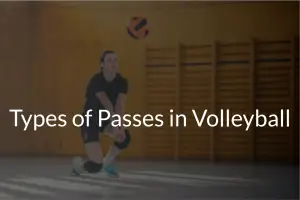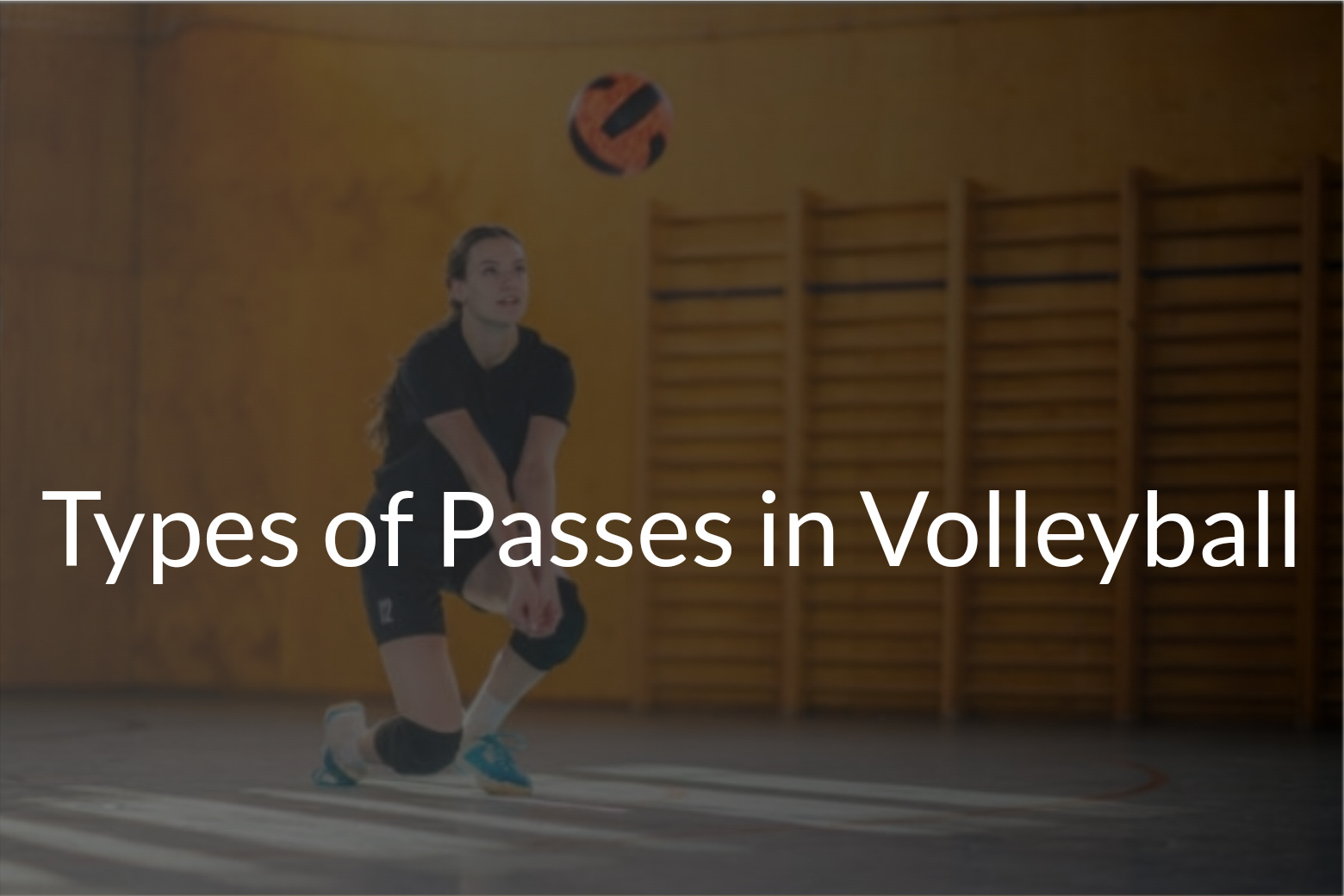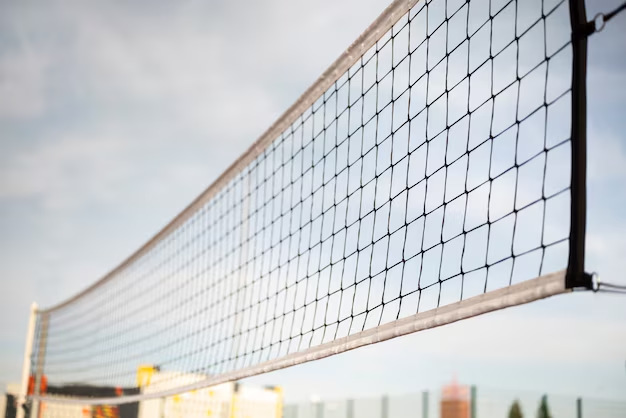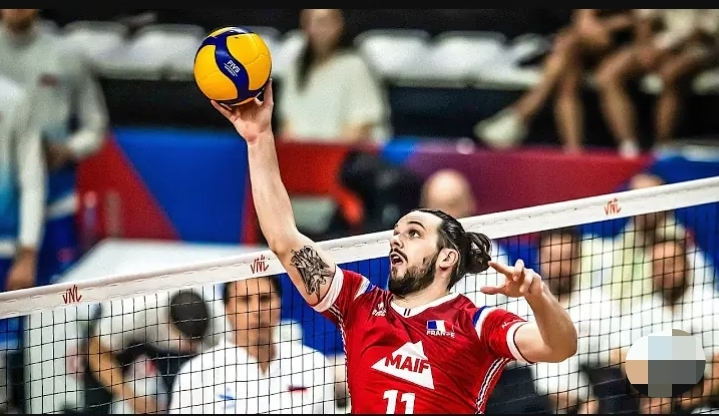Here, we want to look at types of passes in volleyball and various volleyball passing skills. Passing in volleyball is the basic skill in volleyball and the cornerstone of every successful play. Without a solid pass, setting, hitting, and scoring become nearly impossible.
Understanding the various types of volleyball passes is essential for any volleyball player looking to enhance their skills and contribute effectively to their team’s success.
In today’s article, we look at volleyball passes: what they are, types, and various volleyball pass skills. So stay tuned and read to the end. Make sure to comment and share.
What is Volleyball Passes

Volleyball passes refer to the various techniques or actions used by players to receive and control the ball when it is directed towards them in order to send it to a teammate, usually the setter. It’s also known as bumping in volleyball.
These passes are crucial for setting up plays and maintaining possession during a volleyball game. There are several types of passes in volleyball; let’s look at them:
Types of Passes in Volleyball

Types of passes in volleyball are Normal Pass (Forearm Pass), Absorb Pass, Deep Pass, Diving Pass, Pancake Pass, Overhand Pass, and Tomahawk. These are seven types of passes that players use to receive and control the ball.
Here’s a list of the seven most common types of volleyball passes:
- Normal Pass (Forearm Pass)
- Absorb Pass
- Deep Pass
- Diving Pass
- Pancake pass
- Overhand Pass
- Tomahawk
Each type of pass has its own specific use and requires different techniques and skills to execute effectively. Mastering these passes is essential for volleyball players. Let’s look at them in detail.
Check out how to pass a volleyball in the video tutorial below.
1. Normal Pass: Types of Passes in Volleyball
The normal pass, also known as forearm passing, is one of the basic skills in volleyball. It involves using the forearms to control and direct the ball to a teammate or setter.
How to do normal pass in volleyball
Here’s how to execute a proper forearm pass:
- Body Positioning: Start by positioning your body in a stable stance with your feet shoulder-width apart. Bend your knees slightly to lower your center of gravity, which helps with balance and mobility.
- Arm Placement: Extend your arms in front of your body, with your elbows slightly bent and your palms facing upward. Lock your wrists together to create a solid platform for the ball to rebound off.
- Contact: As the ball approaches, focus on making contact with the ball using the flat surface of your forearms, around the wrists. Aim to contact the ball in the center of your forearms, between your wrists and elbows, to achieve maximum control.
- Absorption: As you make contact with the ball, allow your arms to absorb the force of the ball by bending your elbows slightly. This helps to cushion the impact and maintain control over the pass.
- Follow-through: After making contact with the ball, continue to move your arms forward and upward, extending through the ball. This follow-through motion helps to direct the ball accurately to your intended target.
- Footwork: Use quick, light footwork to adjust your positioning and get into the optimal spot to receive the ball. Stay on the balls of your feet, ready to move in any direction as needed.
- Communication: Communicate with your teammates by calling for the ball and indicating your intentions. Clear communication helps to avoid confusion and ensures that everyone is on the same page during the play.
Watch the video tutorial for normal (forearm) passing below.
This pass is good on any ball that is not hard-driven and that you can reach before it reaches below the height of your waist.
I think this is the only pass that should be necessary, but all six players on the court need to use proper footwork in order to reach the ball in time.
Mastering the normal pass takes practice and repetition. Focus on maintaining proper technique, staying balanced, and communicating effectively with your teammates to become a reliable passer on the volleyball court.
See Also:
- What is MB in volleyball? Volleyball position terms explained
- 4 Best Position in Volleyball
- What is MB in volleyball? Volleyball position terms explained
2. Absorb Pass: Volleyball Passes
The absorb pass is a variation of the normal pass used when receiving powerful attack, and the ball is hit with significant force, making it difficult to control with a traditional forearm pass.
How to do Absorb pass in volleyball passes
Here’s how to execute an absorb pass effectively:
- Anticipation: Anticipate the speed and trajectory of the incoming ball. Recognize when a hard-hit ball requires an absorb pass rather than a standard forearm pass.
- Body Positioning: Assume a balanced and stable stance with your feet shoulder-width apart. Bend your knees slightly to lower your center of gravity and prepare to absorb the impact of the ball.
- Arm Placement: Extend your arms in front of your body, similar to the position for a normal pass. Lock your wrists together to create a solid platform for the ball to rebound off.
- Contact: As the ball approaches, focus on making contact with the ball using the flat surface of your forearms, similar to a normal pass. However, instead of attempting to redirect the ball forcefully, allow your arms to absorb the energy of the ball by bending your elbows and leaning backward slightly.
- Absorption: The key difference in the absorb pass is the emphasis on absorbing the force of the ball rather than redirecting it forcefully. By absorbing the energy of the ball, you can control its trajectory and prevent it from rebounding too far away.
- Follow-through: After making contact with the ball, continue to move your arms backward and upward slightly to cushion the impact further. This follow-through motion helps to stabilize the pass and maintain control.
- Recovery: Quickly recover your stance after executing the absorb pass to prepare for the next play. Maintain your balance and readiness to move in any direction as needed.
The goal of an absorb pass is not to make a pinpoint pass on your setter’s head but to keep the ball in play. Remember If the ball hasn’t touched the ground yet, it’s not over yet. Use this pass to absorb the hardest hits and spike the ball.
The absorb pass requires a delicate balance between absorbing the force of the ball and maintaining control over the pass.
3. Deep Pass: Volleyball Passes
The deep pass is a fundamental skill or action in volleyball passes used when the ball is received deep in the court, requiring players to use arm swing to return it to play effectively.
How to do Deep pass
Here’s a step-by-step guide on how to execute a deep pass:
- Positioning: Begin by positioning yourself in a ready stance, with your feet shoulder-width apart and your knees slightly bent. Anticipating ball trajectory and adjust your positioning accordingly.
- Anticipation: Anticipate the flight path and speed of the ball, especially if it’s coming from a hard-hit or high-arcing serve. Position yourself to receive the ball with enough space to execute the deep pass.
- Arm Swing: As the ball approaches, initiate an arm swing to generate momentum for the pass. Start by extending your arms backward, away from your body, to create a wide arc.
- Contact: Time your swing so that your arms reach full extension just as the ball arrives. Make contact with the ball using the flat surface of your forearms, aiming to contact it in the center for maximum control.
- Follow-through: After making contact with the ball, continue the motion of your arm swinging forward and upward, directing the ball towards your intended target. This follow-through motion helps to generate power and accuracy in the pass.
- Footwork: Use quick footwork to adjust your positioning as needed to reach the ball. Maintain balance and stability throughout the pass by staying on the balls of your feet and keeping your body centered.
- Communication: Communicate with your teammates by calling for the ball and indicating your intentions. Clear communication helps to avoid confusion and ensures that everyone is on the same page during the play.
Deep passes are necessary when players are chasing down the ball far outside the court boundary and simply need to pass it a long distance to their teammates or over the net.
4. Diving Pass
The diving pass is a fundamental skill or action in volleyball passes used to reach and control balls that are out of reach for a standard pass. It involves diving towards the ball and making contact with it while in mid-air.
How to execute a driving pass
Here’s how to execute a diving pass effectively:
- Anticipation: anticipating ball trajectory and speed of the incoming ball, recognizing when it’s necessary to dive to reach it. Assess the distance and direction as the ball approaches to determine the best approach for your dive.
- Body Positioning: Position yourself in the path of the ball and prepare to dive towards it. Lower your body by bending your knees slightly and leaning forward, shifting your weight onto the balls of your feet.
- Initiate the Dive: As the ball approaches, initiate the dive by taking a decisive step or leap towards it. Extend your arms forward and lower your torso towards the ground, preparing to make contact with the ball.
- Contact: Time your dive so that you make contact with the ball while in mid-air. Aim to contact the ball with the flat surface of your forearms, similar to a normal pass. Keep your arms extended and your wrists locked to create a stable platform for the ball.
- Absorb Impact: As you make contact with the ball, absorb the impact by allowing your body to cushion the force of the dive. Bend your elbows slightly and relax your muscles to reduce the risk of injury upon landing.
- Follow-through: After making contact with the ball, continue the motion of your dive to ensure that the ball is directed towards your intended target. Extend your arms forward and upward to maintain control over the pass.
- Recovery: Upon landing, quickly recover your position and prepare for the next play. Push off the ground with your arms and legs to regain your balance and readiness to move as needed.
The diving pass requires courage, agility, and precision to execute effectively. With practice and experience, you can become proficient in diving passes, allowing you to reach and control difficult balls with confidence on the volleyball court.
5. Pancake pass: Types of Passes in Volleyball
The pancake pass is one of the volleyball passes used as a last-ditch effort to keep the ball from touching the floor or flat surface when it’s out of reach for a standard pass.
How to execute a pancake pass
Here’s how to execute a pancake pass effectively:
- Anticipation: anticipating ball trajectory and speed of the incoming ball, recognizing when it’s necessary to attempt a pancake pass. Assess the distance and direction of the ball to determine the best approach.
- Positioning: Position yourself in the path of the ball and prepare to make a quick and decisive move to attempt the pancake pass. Lower your body slightly and get ready to react to the ball’s trajectory.
- Timing: Time your movement so that you’re able to get your hand or fist underneath the ball just before it makes contact with the floor. This requires split-second decision-making and quick reflexes.
- Execution: As the ball approaches, extend your hand or fist towards the floor and place it flat on the ground. Keep your fingers together and your palm facing up to create a solid surface for the ball to bounce off.
- Contact: Make contact with the ball using the underside of your hand or fist, ensuring that the ball hits your palm squarely. The goal is to cushion the impact of the ball and redirect it upward to keep it in play.
- Follow-through: After making contact with the ball, continue the motion of your hand or fist to ensure that the ball is directed towards your intended target. Use your wrist and arm to guide the ball upward and back into play.
- Recovery: Quickly recover your position after attempting the pancake pass and prepare for the next play. Get back into position and be ready to move as needed to continue the rally.
The pancake pass requires quick reflexes, precision, and confidence to execute effectively.
6. Overhand Pass: Types of Passes in Volleyball
The overhand pass, also known as the volley, is a fundamental technique used in volleyball to control and direct the ball to a teammate.
How to:
Here’s how to execute an overhand pass effectively:
- Body Positioning: Start by positioning yourself in a stable stance with your feet shoulder-width apart. Bend your knees slightly and maintain a balanced posture to prepare for the pass.
- Hand Position: Raise your hands above your head with your fingers spread apart, forming a platform for the ball to make contact with. Keep your elbows bent at a comfortable angle to provide flexibility and control.
- Anticipation: Anticipate the trajectory and speed of the incoming ball, adjusting your positioning and hand placement accordingly to intercept it.
- Contact: As the ball approaches, make contact with it using the flat surface of your hands. Aim to contact the ball in the center of your hands to achieve maximum control and accuracy.
- Absorption: Absorb the force of the ball by allowing your arms to flex slightly upon contact. This helps to cushion the impact and maintain control over the pass.
- Follow-through: After making contact with the ball, continue the motion of your arms forward and upward to direct the ball towards your intended target. Maintain a smooth and fluid motion to ensure accuracy and consistency in the pass.
- Footwork: Use quick footwork to adjust your positioning as needed to reach the ball. Stay on the balls of your feet and remain agile and ready to move in any direction to maintain balance and control.
- Communication: Communicate with your teammates by calling for the ball and indicating your intentions. Clear communication helps to avoid confusion and ensures that everyone is on the same page during the play.
The overhand pass is a versatile skill that can be used in various situations during a volleyball game, such as receiving serves, setting up plays, and controlling free balls. With practice and experience, you can become proficient in executing overhand passes effectively, contributing to your team’s successful plays.
7. Tomahawk: Volleyball Passes
The Tomahawk pass is a special volleyball passing technique used in volleyball, particularly beach volleyball, as an alternative to setting.
How to:
Here’s how to execute a Tomahawk pass effectively:
- Body Positioning: Position yourself in a stable stance with your feet shoulder-width apart and knees slightly bent. Keep your body balanced and ready to react to the incoming ball.
- Hand Position: Clasp your hands together above your head, as if holding a tomahawk or throwing an axe. Keep your fingers interlocked and your arms extended upward to form a solid platform for the ball.
- Anticipation: Anticipate the trajectory and speed of the incoming ball, adjusting your positioning and hand placement accordingly to intercept it.
- Contact: As the ball approaches, make contact with it using the bottom of your clasped hands. Aim to contact the ball squarely in the center of your hands to achieve maximum control and accuracy.
- Direction and Power: Adjust the angle and power of your tomahawk pass by varying the force and direction of your arm swing. Use your wrists and arms to guide the ball towards your intended target.
- Absorption: Absorb the force of the ball by allowing your arms to flex slightly upon contact. This helps to cushion the impact and maintain control over the pass.
- Follow-through: After making contact with the ball, continue the motion of your arms and wrists to direct the ball towards your intended target. Maintain a smooth and fluid motion to ensure accuracy and consistency in the pass.
- Footwork: Use quick footwork to adjust your positioning as needed to reach the ball. Stay on the balls of your feet and remain agile and ready to move in any direction to maintain balance and control.
The tomahawk pass is the best action that can be used in various situations during a volleyball game, particularly when traditional setting techniques are not feasible.
- 7 Volleyball Conditioning Drills: A Comprehensive Guide for Players
- Volleyball Defense Drills 2024: New Improved
- Grass Volleyball Rules 2024: A Comprehensive Guide for Players
Conclusion
In conclusion, mastering these types of passes in volleyball is an essential and fundamental skill in volleyball. Knowing and practicing the 7 types of volleyball passes, which are: the normal pass, absorb pass, deep pass, diving pass, pancake, overhand pass, and tomahawk, will help you maintain possession, set up plays, and score points.
By practicing these skills regularly and focusing on proper technique, you can improve your passing abilities and contribute to your team’s success. So, don’t just read about these passes—get out there, put them into practice, and watch your game level up!
Read more: Type of One-Hand Pass in Volleyball: A Guide to Mastering This Essential Skill




